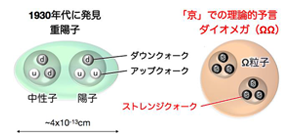
Scientists predict existence of strange particle ‘di-Omega’
Particle containing six quarks predicted by advanced technology and the K computer
Using the K computer, one of the most powerful computers in the world, the HAL QCD Collaboration, a group of scientists from RIKEN, Kyoto University, and Osaka University, have theoretically predicted a particle called ‘di-Omega.’
All matter around us is made up of elementary particles, known as quarks and leptons. Particles made up of three quarks (proton, neutron, and omega) are collectively called baryons, and baryons make up atomic nuclei.
There are six kinds, or flavors, of quarks: Up, Down, Charm, Strange, Top, and Bottom. Protons and neutrons are each composed of three quarks, with protons consisting of two 'Up' quarks and one 'Down' quark and neutrons consisting of two 'Down' quarks and one 'Up' quark. An Omega particle, which is made of three 'Strange' quarks, was found through experiments.
Two baryons bound together are called ‘dibaryons.’ Baryons, which are made up of three quarks, have been found in abundance; however, particles that contain six quarks (dibaryons) have not yet found, save for a deuteron, which contains a proton and a neutron, that was discovered in the 1930s.
In this study, the scientists used the K supercomputer to clarify the force acting between two Omega particles, predicting the existence of di-Omega. A combination of the advancement of theoretical techniques, the development of a computational algorithm, and powerful supercomputers led to this finding.
The exotic dibaryon, made up of two “Omega baryons” that contain three strange quarks each, will likely be found, making it the first hurler in about a century since the discovery of the deuteron. This achievement will also lead to the clarification of a fundamental question of modern physics: how quarks combine to form most of matter.
Illustration images of Supercomputer K (left) and ΩΩ (right)

Figure 1

Figure 2
Figure 3
Figure 4
To learn more about this research, please view the full research report entitled " Most Strange Dibaryon from Lattice QCD " a t this page of Physical Review Letters .
Related links

